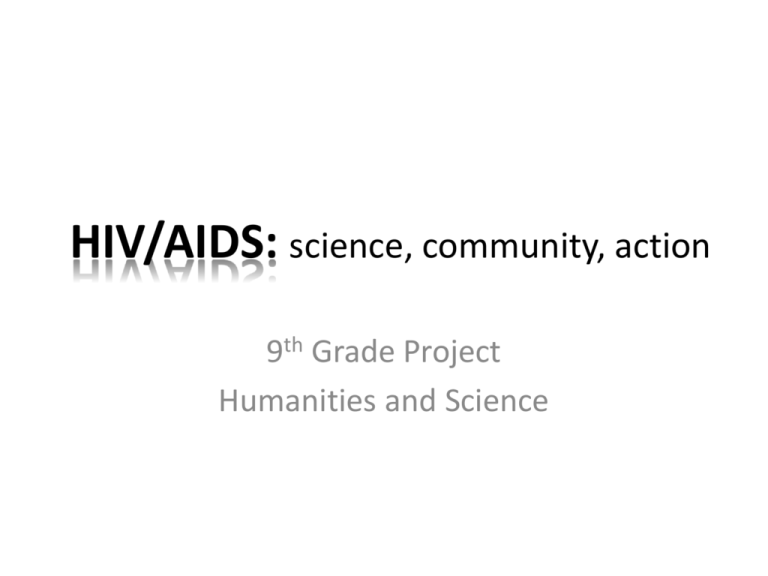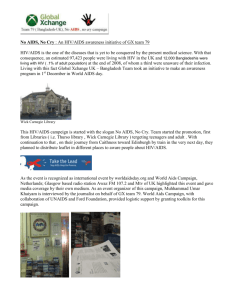HIV/AIDS: science, community, action
advertisement

HIV/AIDS: science, community, action 9th Grade Project Humanities and Science Driving Questions "How can I stop AIDS from killing my friends and community?" "How can I support people affected with HIV/ AIDS?" "How can I prevent the stigmatization if HIV/ AIDS?" PROJECT CALENDAR Humanities Week of Science Joint launch-create a need-to-know April 6 Design History and Biology April 13 Create Cells & immune system April 20 Implement/Community Service + guest speakers Biology of AIDS Treatment & Prevention Essay Research + Planning Assessment-Teaching April 27 May 4 Mini-exhibitions May 11 Assessment-Essay Writing Reflection + Essay Writing History & Current Statistics Human Body Deep-Dive The Biology of AIDS • cell structure • organs • immune system • transmission • invasion & release • immune suppression • opportunistic infection Treating & Preventing • existing meds • vaccines in progress Deliverables: Week 1 Week 2 Week 3 Week 4 (Apr 6-10) (Apr 13-17) (Apr 20-24) (Apr 27-1) Summative Formative Humanities Science Conversation/academic argument HIV/AIDS Elevator Speech Ethical Question graphic organizer Immune System Graphic Research notes Model/Analogy Outline Lesson Plan Persuasive Essay HIV/AIDS mini-lesson Reflection & self-assessment Reflection & self-assessment Science Assessment Notes HIV/AIDS Elevator Speech Students develop a oneminute speech to communicate the importance of HIV/AIDS and contextualize the issue for a young person 3 notecards: • logos (the logical argument, including history and current statistics) • ethos (communicate your connection and your level of commitment and knowledge) • pathos (use empathy to appeal to your listener) Oral Delivery: Student will deliver the speech to instructor/peer…and it will become part of their lesson plan Immune System Graphic Students develop a small comic/cartoon, graphic novel, or interactive game that could be used to teach a middle school student about the biology of the cell and immune system Model/Analogy Lesson Plan Students come up with a model or analogy that accurately represents the mechanism by which the HIV virus infects the human body (e.g. a pirate ship…pirates invade neighboring ships, etc…) Students develop a lesson plan to explain the science and treatment of HIV/AIDS to a young patient who tested positive. HIV/AIDS minilesson Students teach their lesson to one or more 6th/7th graders as ‘practice’ for their conversation with a patient Reflection & self-assessment Students write a guided reflection, which can become part of their eportfolio Students complete the same rubric that their teacher is using to self-assess their own work







